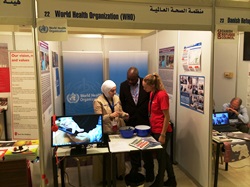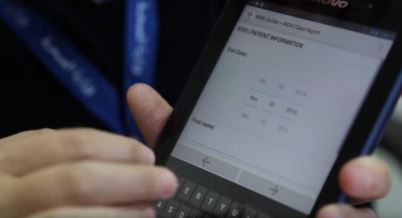 WHO showcases the new mobile public health surveillance system in Jordan, and the training programme for Syrian refugee doctors and nurses living in Turkey, at the Resilience and Development Forum Expo. Credit: WHO/J.Swan16 December | Amman – WHO recently participated in the regional Resilience and Development Forum at the Dead Sea, Jordan – a meeting which brought together government officials, donors, and heads of United Nations agencies and civil society organizations, to discuss and chart the future directions of the Syria crisis response. Organized by the United Nations Development Programme and hosted by the Government of Jordan, the Forum enabled multi-level policy deliberations on priority areas of intervention and strategic partnership for collective response to the crisis inside Syria and in neighbouring countries hosting Syrian refugees.
WHO showcases the new mobile public health surveillance system in Jordan, and the training programme for Syrian refugee doctors and nurses living in Turkey, at the Resilience and Development Forum Expo. Credit: WHO/J.Swan16 December | Amman – WHO recently participated in the regional Resilience and Development Forum at the Dead Sea, Jordan – a meeting which brought together government officials, donors, and heads of United Nations agencies and civil society organizations, to discuss and chart the future directions of the Syria crisis response. Organized by the United Nations Development Programme and hosted by the Government of Jordan, the Forum enabled multi-level policy deliberations on priority areas of intervention and strategic partnership for collective response to the crisis inside Syria and in neighbouring countries hosting Syrian refugees.
Representing WHO at the roundtable discussions were Assistant Director General Dr Bruce Aylward, and WHO Representative to Syria Ms Elizabeth Hoff.
“The Forum was important as it brought together key stakeholders from across the Region to discuss the increasing need for longer term, more sustainable interventions in the Syria response,” said Dr Aylward. “The meeting was also a platform to advocate for continued support and funding for health, as a critical component of the response, and to position health high on the agenda for resilience plans in the Region,” he said.
“Building the resilience of individuals, communities and institutions within Syria has always been one of WHO’s strategic objectives,” said Ms Hoff. “Not only are we addressing the immediate relief health needs of affected populations across the country; we are also implementing longer term interventions by strengthening institutional capacities, service delivery, and the coping mechanisms of affected populations. The Forum emphasized the importance of this dual approach,” she said.
In the Forum's Resilience-Building and Innovation Marketplace, WHO showcased 2 projects from its Jordan and Turkey country offices designed to build local capacities. On display was the successful implementation of a national public health surveillance system utilizing mobile tablet technology by the Jordanian Ministry of Health and WHO. WHO Turkey’s adaptation training for Syrian refugee health professionals was also featured. The project, developed in conjunction with the Turkish Ministry of Health and Gaziantep University, qualifies Syrian doctors and nurses to treat fellow Syrian refugees in Turkey. WHO Syria, collaboratively with the Syria UN Country Team, highlighted the resilience Strategic Plan for 2016–2017, and showcased multiple ongoing resilience-building interventions, including building the national Early Warning and Response System (EWARS) and Health Resource Availability Mapping System (HeRAMS).
“We were very proud to exhibit these innovative projects in the Forum’s Marketplace,” said WHO Emergency Support Team Coordinator Dr Nada Al Ward. “These are strong examples of how WHO is using proactive and innovative means to build resilience in the response. The exhibition was also a valuable opportunity to identify synergies between organizational programmes, so that we can strengthen collaboration as we move forward,” she said.
Piloted in 2013 and now used in 293 data reporting sites across the country, WHO Jordan’s public health surveillance initiative replaces a paper-based disease system and allows for easier data collection, real-time information sharing, and rapid detection and response to disease outbreaks. In Turkey, comprehensive training has familiarized 66 Syrian refugee doctors and 34 Syrian refugee nurses with the Turkish health care system, enabling them to provide primary health care-level services to Syrian patients living in camps and among host communities.
“The projects have been very successful to date,” said Dr Al Ward. “WHO Jordan’s mobile system has aided considerably in the expansion of public health surveillance in Jordan, and real-time information has helped the Ministry of Health and WHO keep on the front foot in terms of response to suspected cases of priority diseases,” she added. “WHO Turkey’s project is addressing a major language barrier problem and helping to decongest health facilities. It also serves to create job opportunities for Syrian refugees,” she said.
WHO is in discussion with Member States to expand adoption of its mobile surveillance system in the Region and by the end of 2015, WHO aims to have trained 175 Syrian doctors and 75 nurses on the Turkish health care system. The projects are funded by the Government of Kuwait, and ECHO and the Central Emergency Response Fund, respectively.
WHO Syria’s EWARS builds on 983 sentinel sites reporting from health facilities across the country (over 30% in hard-to-reach and opposition-controlled areas). Its HeRAMS covers the whole country and provides timely, reliable information on available health resources and services to inform decision-making, planning and evidence-based interventions. Since 2013, WHO Syria has capacitated over 32 000 health workers in various aspects of health care management and delivery, including mental health, trauma, reproductive health, primary and secondary health care, in order to bridge the gap resulting from the exit of over 45% of Syria’s health work force due to the crisis.
More than 300 delegates and 27 exhibitors participated in the Resilience and Development Forum. Key speakers included Prime Minister of Jordan Dr Abdullah Ensour, United Nations Development Programme Administrator Helen Clark, and United Nations High Commissioner for Refugees Antonio Guterres.
Related link
Video
Jordan Public Health Surveillance Programme
The national public health surveillance project initiated in Jordan in April 2015 introduces case-based, integrated disease surveillance of mental health, noncommunicable disease and communicable disease, and is programmed using mobile technology and an online framework.




